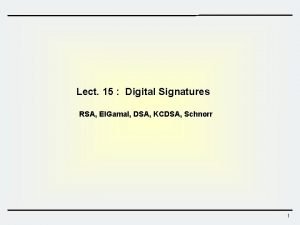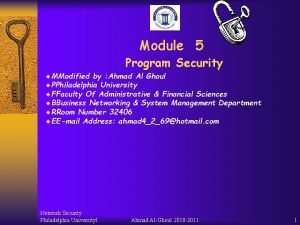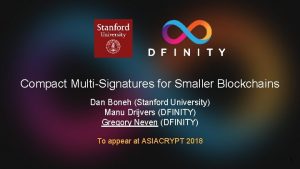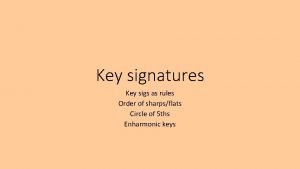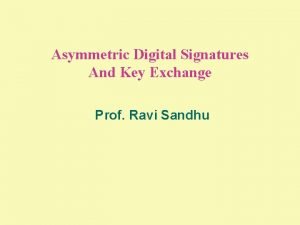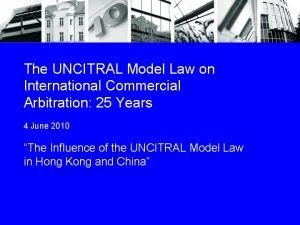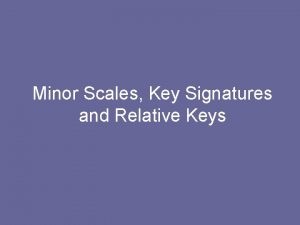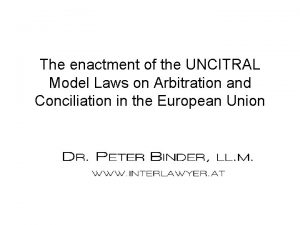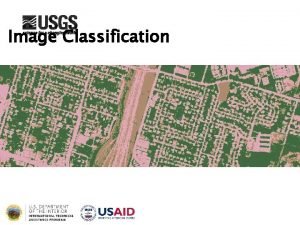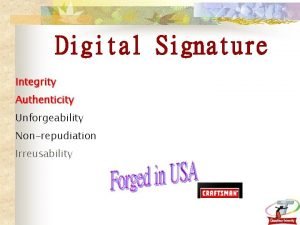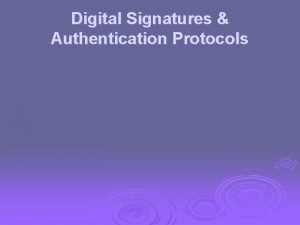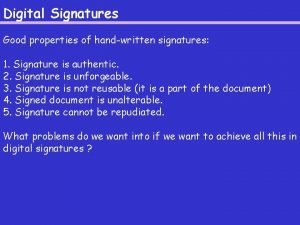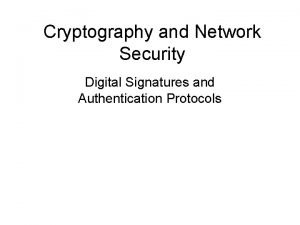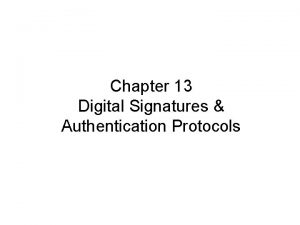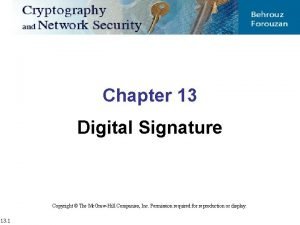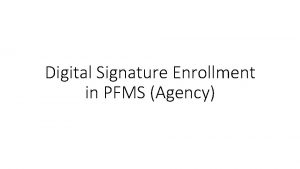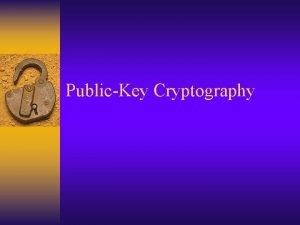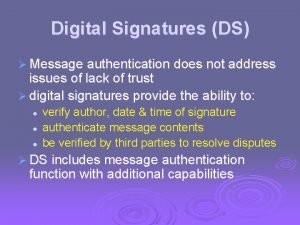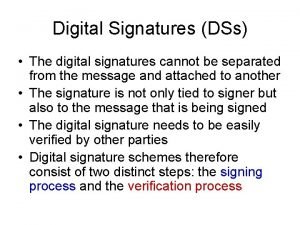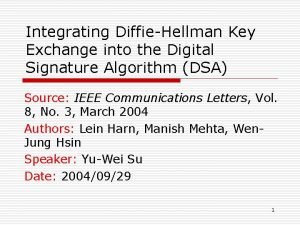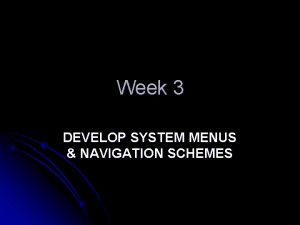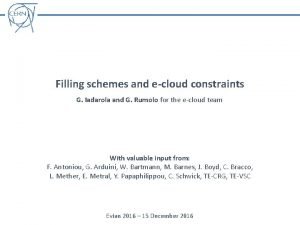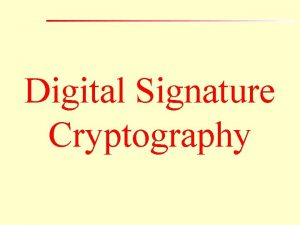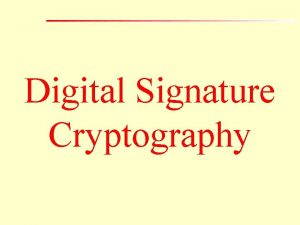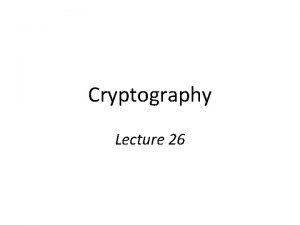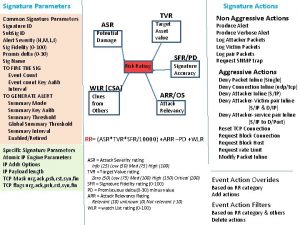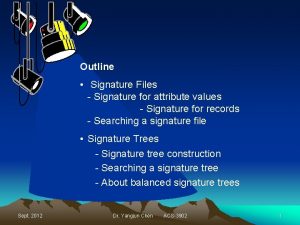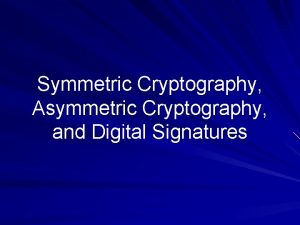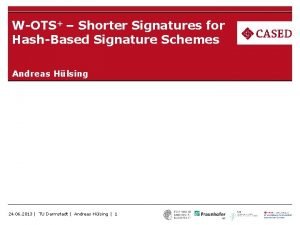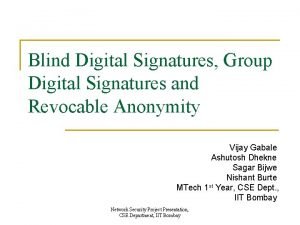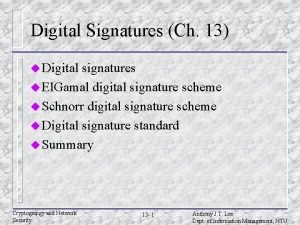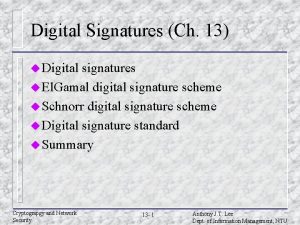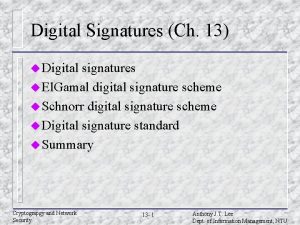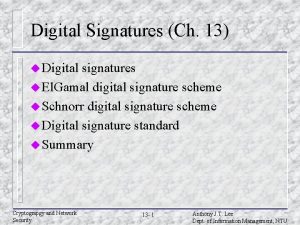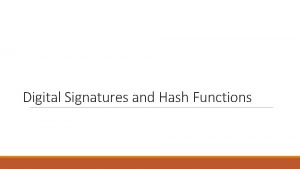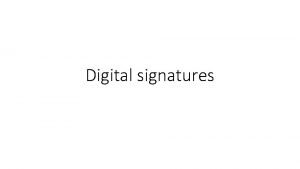Cryptography Lecture 26 Digital signatures Signature schemes A














![“Plain” RSA signatures N, e m, m =? [ e mod N] (N, e, “Plain” RSA signatures N, e m, m =? [ e mod N] (N, e,](https://slidetodoc.com/presentation_image/1d427975cf62b01db21cda06833cb625/image-15.jpg)



















- Slides: 34

Cryptography Lecture 26

Digital signatures

Signature schemes • A signature scheme is defined by three PPT algorithms (Gen, Sign, Vrfy): – Gen: takes as input 1 n; outputs pk, sk – Sign: takes as input a private key sk and a message m {0, 1}*; outputs signature Signsk(m) – Vrfy: takes public key pk, message m, and signature as input; outputs 1 or 0 For all m and all pk, sk output by Gen, Vrfypk(m, Signsk(m)) = 1

Security? • Threat model – “Adaptive chosen-message attack” – Assume the attacker can induce the sender to sign messages of the attacker’s choice • Security goal – “Existential unforgeability” – Attacker should be unable to forge valid signature on any message not signed by the sender • Attacker gets the public key…

Formal definition • Fix A, • Define randomized experiment Forge. A, (n): 1. pk, sk Gen(1 n) 2. A given pk, and interacts with oracle Signsk(·) ; let M be the set of messages sent to this oracle 3. A outputs (m, ) 4. A succeeds, and the experiment evaluates to 1, if Vrfypk(m, )=1 and m M

Security for signature schemes • is secure if for all PPT attackers A, there is a negligible function such that Pr[Forge. A, (n) = 1] ≤ (n)

Replay attacks • Replay attacks need to be addressed just as in the symmetric-key setting

Hash-and-sign paradigm • Given – A signature scheme = (Gen, Sign, Vrfy) for “short” messages of length n – Hash function H: {0, 1}* {0, 1}n • Construct a signature scheme ’=(Gen, Sign’, Vrfy’) for arbitrary-length messages: – Sign’sk(m) = Signsk(H(m)) – Vrfy’pk(m, ) = Vrfypk(H(m), )

Hash-and-sign paradigm • Theorem: If is secure and H is collisionresistant, then ’ is secure • Proof: Say the sender signs m 1, m 2, … – Let hi = H(mi) • Attacker outputs forgery (m, ), m mi for all i • Two cases: – H(m) = hi for some i • Collision in H! – H(m) hi for all i • Forgery in the underlying signature scheme

Hash-and-sign paradigm • Same idea as in the hash-and-MAC paradigm • Can be viewed as analogous to hybrid encryption – The functionality of digital signatures at the asymptotic cost of a symmetric-key operation

Signature schemes • We will discuss how to construct signature schemes for “short” messages – Using hash-and-sign, this implies signatures for arbitrary length messages

Signature schemes in practice • RSA-based signatures – Can be proven secure (based on RSA assumption, in random-oracle model) • Dlog-based signatures – Shorter signatures, faster signing than RSA-based signatures – (EC)DSA • Widely used, no proof of security – Schnorr • Can be prove secure (based on dlog assumption, in randomoracle model)

RSA-based signatures

Recall… • Choose random, equal-length primes p, q • Compute modulus N=pq • Choose e, d such that e · d = 1 mod (N) • The eth root of m modulo N is [md mod N] (md)e = mde = m[ed mod (N)] = m mod N • RSA assumption: given N, e only, hard to compute the eth root of a uniform m ℤ*N 14
![Plain RSA signatures N e m m e mod N N e “Plain” RSA signatures N, e m, m =? [ e mod N] (N, e,](https://slidetodoc.com/presentation_image/1d427975cf62b01db21cda06833cb625/image-15.jpg)
“Plain” RSA signatures N, e m, m =? [ e mod N] (N, e, d) RSAGen(1 n) pk = (N, e) sk = d = [md mod N]

Security? • Intuition – Signature of m is the eth root of m – supposedly hard to compute!

Attack 1 • Can sign specific messages – E. g. , easy to compute the eth root of m = 1, or the cube root of m = 8

Attack 2 • Can generate signatures on “random” messages – Choose arbitrary ; set m = [ e mod N]

Attack 3 • Can combine two signatures to obtain a third – Say 1, 2 are valid signatures on m 1, m 2 with respect to public key N, e – Then ’ = [ 1 · 2 mod N] is a valid signature on the message m’ = [m 1 · m 2 mod N] • ( 1 · 2)e = 1 e · 2 e = m 1 · m 2 mod N

RSA-FDH • Main idea: apply a “cryptographic transformation” to messages before signing • Public key: (N, e) private key: d • Signsk(m) = H(m)d mod N – H must map onto all of ℤ*N • Vrfypk(m, ): output 1 iff e = H(m) mod N • (This also handles long messages without additional hashing)

Intuition for security? • Look at the three previous attacks… – Not easy to compute the eth root of H(1), … – Choose …, but how do you find an m such that H(m) = e mod N? • Computing inverses of H should be hard – H(m 1) · H(m 2) = 1 e · 2 e = ( 1 · 2)e ≠ H(m 1 · m 2)

Security of RSA-FDH • If the RSA assumption holds, and H is modeled as a random oracle (mapping onto ℤ*N), then RSA-FDH is secure • In practice, H is instantiated with a (modified) cryptographic hash function – Must ensure that the range of H is large enough!

RSA-FDH in practice • The RSA PKCS #1 v 2. 1 standard includes a signature scheme inspired by RSA-FDH – Essentially a randomized variant of RSA-FDH

dlog-based signatures

Digital signature standard (DSS) • US government standard for digital signatures – DSA, based on discrete-logarithm problem in subgroup of ℤp* – ECDSA, based on elliptic-curve groups – See book for details • Compared to RSA-based signatures – Shorter signatures and public keys (for EDCSA) – Can have faster signing – Slower verification

Public-key infrastructure (PKI)

Public-key distribution Alice, pk* pk Alice, pk pk* X Alice, pk pk, sk

Public-key distribution pk Alice, pk X Alice, pk* pk, sk

Use signatures for secure key distribution! • Assume a trusted party with a public key known to everyone – CA = certificate authority – Public key pk. CA – Private key sk. CA

Use signatures for secure key distribution! • Alice asks the CA to sign the binding (Alice, pk) cert. CA Alice = Signsk. CA(Alice, pk) • (CA must verify Alice’s identity out of band)

Use signatures for secure key distribution! • Bob obtains Alice, pk, and the certificate cert. CA Alice … – … check that Vrfyp. KCA((Alice, pk), cert. CA Alice) = 1 • Bob is then assured that pk is Alice’s public key – As long as the CA is trustworthy… • Honest, and properly verifies Alice’s identity – …and the CA’s private key has not been compromised

Chicken-and-egg problem? • How does Bob get pk. CA in the first place? • Several possibilities…

“Roots of trust” • Bob only needs to securely obtain a small number of CA’s public keys – Need to ensure secure distribution only for these few, initial public keys • E. g. , distribute as part of an operating system, or web browser – Firefox: Tools->Options->Privacy & Security->View Certificates->Authorities

“Web of trust” • Obtain public keys in person – “Key-signing parties” • Obtain “certificates” on your public key from people who know you • If A knows pk. B, and B issued a certificate for C, then C can send that certificate to A – What trust assumptions are being made here?
 Digital signature in cryptography and network security
Digital signature in cryptography and network security El gamal digital signature
El gamal digital signature Digital data to digital signal encoding
Digital data to digital signal encoding Intruders use virus signatures fabricate
Intruders use virus signatures fabricate Natural selection
Natural selection Compact multi-signatures for smaller blockchains
Compact multi-signatures for smaller blockchains Key signature rules
Key signature rules Exchange 2007 signatures
Exchange 2007 signatures Uncitral model law on international commercial arbitration
Uncitral model law on international commercial arbitration Beadgcf flats
Beadgcf flats Uncitral model law on electronic transferable records
Uncitral model law on electronic transferable records Ocaml signatures
Ocaml signatures Minimum distance classifier
Minimum distance classifier Non-repudiation digital signature
Non-repudiation digital signature Digital signature authentication protocol
Digital signature authentication protocol Digital certificate example
Digital certificate example Properties of digital signature
Properties of digital signature Digital signature authentication protocol
Digital signature authentication protocol Digital signature authentication protocol
Digital signature authentication protocol Message authentication code
Message authentication code Digital signature algorithm
Digital signature algorithm Rsa digital signature
Rsa digital signature Digital signature forgery
Digital signature forgery Message authentication in network security
Message authentication in network security Pfms dsc
Pfms dsc Digital signature crossword
Digital signature crossword Digital signature
Digital signature Dss digital signature
Dss digital signature Diffie hellman signature
Diffie hellman signature 01:640:244 lecture notes - lecture 15: plat, idah, farad
01:640:244 lecture notes - lecture 15: plat, idah, farad New and navigation schemes selection of window
New and navigation schemes selection of window Poster color schemes
Poster color schemes Quatrain poem
Quatrain poem Filling schemes
Filling schemes Wecs schemes
Wecs schemes

